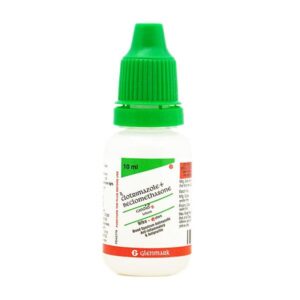BECLOMETHASONE + CLOTRIMAZOLE + CO-TRIMOXAZOLE
Beclomethasone: Beclomethasone is a medication that belongs to the class of drugs known as corticosteroids. It is commonly used in the treatment of respiratory conditions such as asthma, allergic rhinitis, and chronic obstructive pulmonary disease (COPD).
The primary mechanism of action of beclomethasone is its anti-inflammatory properties. It works by reducing the inflammation in the airways, thereby relieving symptoms such as wheezing, coughing, and shortness of breath. It also helps to prevent the occurrence of asthma attacks and other respiratory symptoms triggered by allergens or irritants.
Beclomethasone is usually administered through an inhaler device, where it is directly delivered to the lungs. The dosage of beclomethasone varies depending on the severity of the condition and individual response. It is typically recommended to start with a low dose and gradually increase if necessary. The dosage is usually prescribed by a healthcare professional and may need adjustment over time.
Like any medication, beclomethasone can cause side effects. Common side effects include throat irritation, hoarseness, coughing, and fungal infections in the mouth. These side effects can be minimized by rinsing the mouth with water after each use of the inhaler. Long-term use or high doses of beclomethasone may also lead to systemic side effects such as adrenal suppression, osteoporosis, and changes in mood or behavior.
It is important to note that beclomethasone should be used only as directed by a healthcare professional. It should not be used as a rescue medication for sudden breathing problems. If you experience severe or worsening side effects, it is crucial to seek immediate medical attention.
Clotrimazole: Clotrimazole is an antifungal medication used to treat various fungal infections. It is commonly available as a cream, lotion, or solution.
Mechanism of Action:
Clotrimazole works by inhibiting the growth of fungi, including yeasts and dermatophytes. It does so by altering the permeability of fungal cell membranes, leading to the leakage of essential cellular components and ultimately causing cell death.
Use:
Clotrimazole is primarily used to treat fungal infections of the skin, such as athlete’s foot (tinea pedis), jock itch (tinea cruris), and ringworm (tinea corporis). It can also be used to treat vaginal yeast infections (vulvovaginal candidiasis) and oral thrush (oral candidiasis).
Dose:
The dosage and application of clotrimazole may vary depending on the specific condition being treated. It is advisable to follow the instructions provided by the prescribing healthcare professional or the instructions on the product label. Typically, clotrimazole cream or lotion is applied to the affected area 2-3 times daily for 2-4 weeks. For vaginal yeast infections, clotrimazole is available as vaginal tablets that are inserted high into the vagina once daily for 3-7 days.
Side Effects:
Clotrimazole is generally well-tolerated, and side effects are rare. However, some individuals may experience mild skin irritation, including redness, itching, or stinging at the application site. If these symptoms persist or worsen, it is advisable to consult a healthcare professional. Some people may also be hypersensitive to clotrimazole, resulting in an allergic reaction. Signs of an allergic reaction include rash, itching, swelling, severe dizziness, or difficulty breathing. In such cases, immediate medical attention should be sought.
It is important to note that this is a general overview of clotrimazole. The specific instructions and recommendations provided by the healthcare professional or product label should always be followed for accurate and safe use of the medication.
Co-Trimoxazole: Co-Trimoxazole, also known as Trimethoprim/Sulfamethoxazole, is a combination antibiotic drug that is used to treat various bacterial infections. It contains two active ingredients – trimethoprim and sulfamethoxazole – which work together to inhibit the growth of bacteria.
The mechanism of action of Co-Trimoxazole involves blocking different steps in the bacterial folic acid synthesis pathway. Trimethoprim inhibits the enzyme dihydrofolate reductase, which is essential for the production of tetrahydrofolate, a precursor of DNA and RNA. Sulfamethoxazole, on the other hand, acts as a competitive inhibitor of dihydropteroate synthase, an enzyme involved in folic acid synthesis. By targeting both of these enzymes, Co-Trimoxazole disrupts bacterial growth and replication.
Co-Trimoxazole is commonly used to treat respiratory tract infections, urinary tract infections, skin and soft tissue infections, traveler’s diarrhea, and certain types of pneumonia. It is also used as a prophylactic treatment for certain opportunistic infections in individuals with compromised immune systems.
The recommended dose of Co-Trimoxazole varies depending on the type and severity of the infection. It is typically administered orally, but intravenous formulations are available for severe infections. It is important to follow the prescribed dosage and complete the full course of treatment, even if symptoms improve before the medication is finished.
Like any medication, Co-Trimoxazole can cause side effects. Common side effects include nausea, vomiting, diarrhea, headache, and rash. Some individuals may experience allergic reactions, such as itching, hives, or swelling. More serious side effects, although rare, can include blood disorders, liver problems, and severe skin reactions. If any unusual or severe side effects occur, medical attention should be sought immediately.
Co-Trimoxazole may interact with other medications, so it is important to inform your healthcare provider about any other drugs you are taking. Additionally, it may not be suitable for individuals with certain medical conditions, such as kidney or liver disease, asthma, or allergies to sulfonamide drugs.
In summary, Co-Trimoxazole is a combination antibiotic used to treat bacterial infections. It works by inhibiting key steps in folic acid synthesis within the bacteria. The recommended dose varies depending on the infection being treated. While generally well-tolerated, common side effects may include nausea, vomiting, and rash. It is essential to complete the full course of treatment and seek medical attention if any severe side effects occur.

